After a 3-day trip to the first Ramsar site in India, I realized how scientific techniques twinned with community-awareness can help a declining habitat flourish in many ways
Exploring Chilika is like flying off into space—the vast shores and endless horizon hide a multitude of mysteries. With the magnificent Eastern Ghats in the backdrop, a boat ride here in any part of the lake is a mesmerizing affair, as the sky and water melt into each other. Located south of the Mahanadi delta, it is spread over Puri, Khurda and Ganjam districts of Odisha. It is the second largest lagoon in the world, getting sea water from the Bay of Bengal and fresh water from rivers and streams. Given the biodiversity that thrives here, Chilika Lake feeds aquatic species and humans alike.
Chilika Lake, Odisha, is the largest brackish water lagoon in Asia. Covering an area of over 1,165 sq. km, it is home to over 323 aquatic species, which include the endangered Irrawaddy Dolphins and Olive-Ridley Turtles and more.
The lake is deep, I thought to myself as the boat sped towards Kalijai Island near Barkul. Sea gulls flew around the boats that offered them food. It was a moment I managed to capture.
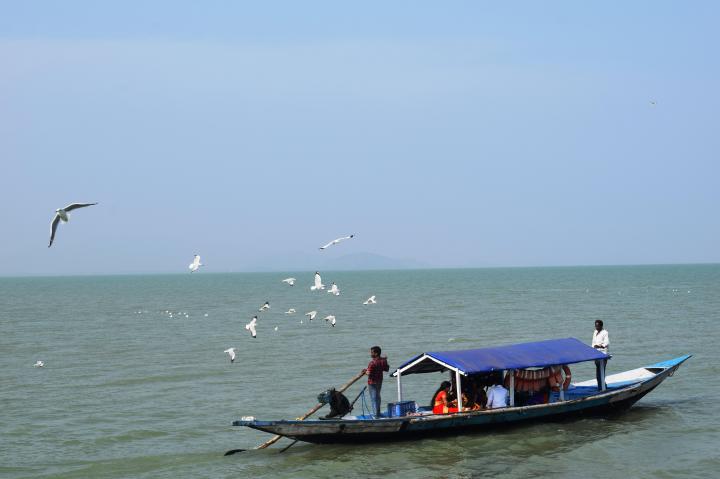
There are many other parts to enjoy the biodiversity, out of which I visited Barkul, Rambha and Mangalajodi. Here, I realized why the lake is such a precious natural resource and how natural degradation had been reversed. In fact, the model became a global case study for other countries to emulate in their wetlands, and even a UNESCO article cites this.
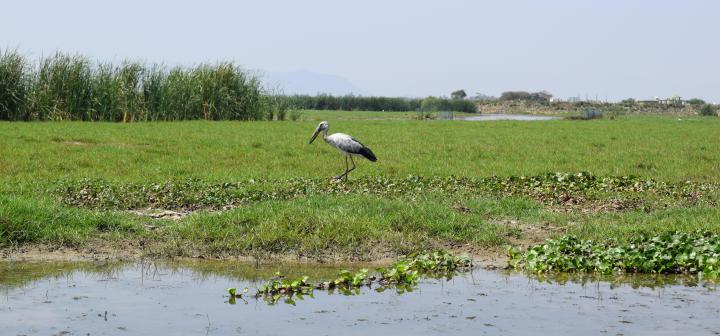
Let me share the background of the lake, before I tell you about my trip to Mangalajodi and meeting the saviours of the marshy land.
Natural Resources Have a Life too
Chilika Lake is separated from the Bay of Bengal by a sandy ridge. Besides supporting aquatic flora and fauna, the water body is a source of livelihood for more than two lakh fishers, supporting 132 villages that live around its shores.
While the wetland was declared a Ramsar Site in 1981, the ecology degraded over the years, as the mouth of the lake was choked by siltation and sedimentation, leading to other problems. In 1993, the lake was placed on Montreux Record. Chilika Development Authority (CDA), under the aegis of the Government of Odisha, sprang into action and made a restoration plan. In 2002, the lake was pulled out of the record and also won the Ramsar Wetland Conservation Award in the same year.
Actions taken to restore Chilika Lake
1. An ‘Ecosystem Health Report Card’, first of its kind in Asia, was developed in collaboration with Maryland University and National Centre for Sustainable Coastal Management, Chennai. This is a quantitative assessment of lake health based on; Water clarity, Dissolved oxygen, Chlorophyll-a, Total catch, Commercial fish species diversity, Bird count and richness, Dolphin abundance, Benthic faunal diversity and Phytoplankton diversity.
2. Installation of the sensor mounted floating data buoys at 10 strategic locations for transmission of the water quality data on real-time basis at 15 minutes intervals to the CDA Laboratory at Chilika.
3. Upgradation of Wetlands Research & Training Center (WRTC) with a state-of-the-art lab, equipped with all modern research facility for wetland research.
4. Bridging knowledge gaps with five scientific studies:
(i) Comprehensive studies on water birds by Bombay Natural History Society, Mumbai
(ii) Fishery resources by ICAR-Central Inland Fisheries Research Institute. Kolkata
(iii) Study on the Benthos and meibenthos by Indian Institute of Science Education and Research, Pune
(iv) Study of microbes by KIIT School of Biotechnology, Bhubaneswar
(v) Study of macrophytes by Regional Plant Research Center, Bhubaneswar.
5. A documentary by renowned filmmaker Shekar Datatri to spread awareness.
6. Outreach programme ‘Rangers of Chilika’ was launched in collaboration with ‘Barefoot’, NGO from Puri. Awareness sessions and workshops with the communities dependent on the lake were held.
Flora & Fauna of Chilika Lake
The largest wintering ground for migratory birds, Chilika Lake is the ‘jewel of Odisha’. Nalabana Bird Sanctuary is the core area of the Ramsar-designated wetland. Birds come from as far as the Caspian Sea, Lake Baikal, Aral Sea and other remote parts of Russia, Kirghiz steppes of Mongolia, Central and Southeast Asia, Ladakh and Himalayas.
During the peak season, it is home to Flamingo, White Bellied Sea Eagle, Brahminy Kite, Spot-billed Pelican, Bar-headed Goose, Open-billed Stork, Spoonbill, Brahminy Duck, Wigeon, Pintail, Shoveler, Ibis, Stilt, Heron, Egret, Avocet, Gull, Tern and Kingfisher around the lake and on the many islands within the lake.
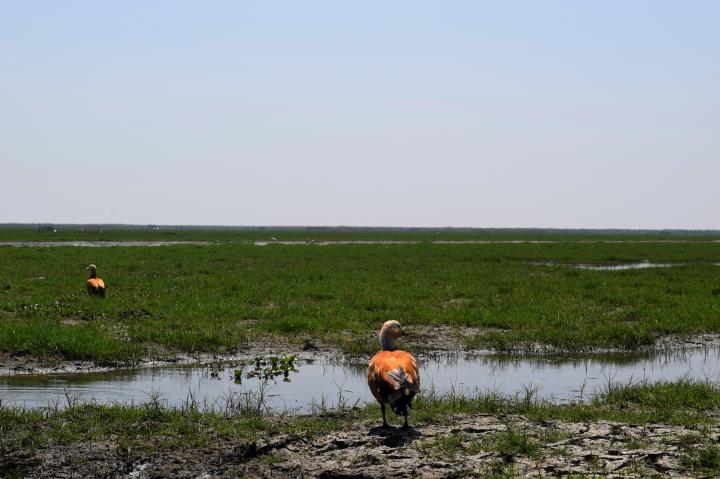
The thick tall-grass habitat in the northeastern part of the lagoon is the breeding ground of residential birds like Coots, Moorhens, Jacanas, Stilts, Dabchicks, Weaver bird and other species. Around 726 species of flowering plants have been documented here.
The lake also plays host to a few estuarine Turtles and Snakes; rare limbless skink and dugongs have been recorded here.
An afternoon lesson in birding at Mangalajodi
Chilika Lake became larger than life when I met poachers-turned-protectors at Mangalajodi. This is a fresh water zone connected by channels cut through the reed beds with the brackish water of Chilika lagoon.
The boatmen and the guides leading boat tours inside the 10 sq.km marshy channels are erstwhile poachers, now protectors and naturalists. The tours operate under the banner of Sri Sri Mahavir Pakshi Surakshya Samiti of Mangalajodi. The proud guardians were trained by the Chilika Development Authority, the forest department and Wild Orissa, an organization for conservation of wildlife and nature.

“The bird count had fallen to 5,000 in 2000,” said my guide, who parked me firmly in the front bow of the small, narrow wooden boat. Like the reeds, the boat was dark green and both, he and the boatman. wore greens too, blending with the natural habitat. “We would often kill these exotic species for sale and even our own consumption. But we were taught the folly of how we would lose the entire ecology and never have food.”
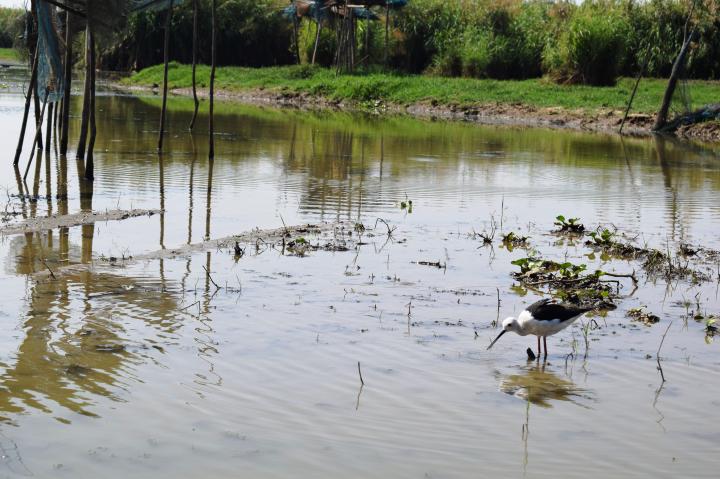
As a critical bird breeding habitat for a large variety of resident birds, Mangalajodi is among the most prized eco-tourism reserves in the state. With its significant global waterfowl habitat, it has been declared as an ‘Important Bird Area (IBA)’.
My guide started shooting out the names, pointing out the small birds near the shore. He had a big fat book on birding. “Do you understand English? How many birds come here now?” I asked.
“We were taught all the basics,” he replied. “I know all the pictures and about the birds and their names.”
This marshland has over 3,00,00 birds, which include Grebes, Cormorants/Shags, Herons, Egrets and Bitterns, Storks, Ibises, Geese and Ducks, Raptors, Pheasants, Partridges, Quails, Rails, Crakes, Moorhens, Coots, Jacanas, Waders, Gulls & Terns, Kingfishers, the rare Fishing Cat, Illisha (Hilsa illisha), Khainga (Mullet), Bhekti, Kanna and more.
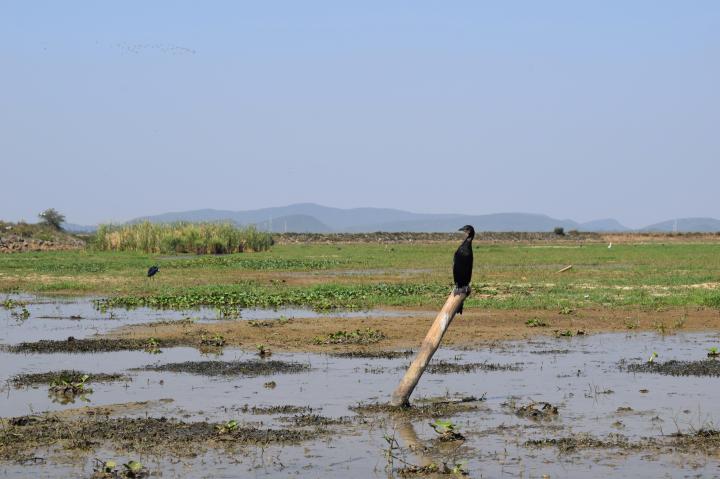
Natives say that the village was named after the twin temples in the area. Mangal means welfare and jodi is twins.
As I didn’t have a telescopic lens, the boatman tried to take us as close to the birds as possible. But it wasn’t an easy task, and I didn’t try any stunts. My guide carried a pair of binoculars and handed me the pair to show me the formations in the sky.
I captured quite a few, watch the antics, the fights, the patterns they make in the sky and marvelled at the creation. “If you had the big lens, you would have got an award-winning video and picture,” my guide said. I just nodded, smiling ruefully. If I had come in the morning, then I would have seen more. But I had come at noon!
He also pointed out the watch towers, telling me that there were regular patrols and anti-poaching camps. For the lake to remain healthy, there has to be regular monitoring.
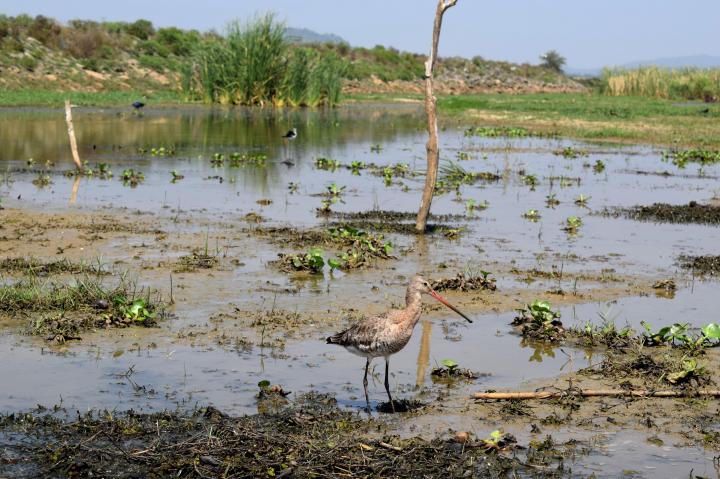
I watched a dead snake float by, frogs jump in and out of the water, fishermen taking their catch out and the birds were indifferent to us. The boat ride was for an hour and then the narrow, wooden transportation turned back towards the starting point.
Sunrise at Rambha
Surrounded by hills, the sunrise at Rambha is as exotic as the birds here. We had reached late in the evening, so I had an early night, turned out to be a good decision. I did have plans to take a boat tour of the islands here. But then, I decided that I would just explore the neighbourhood.
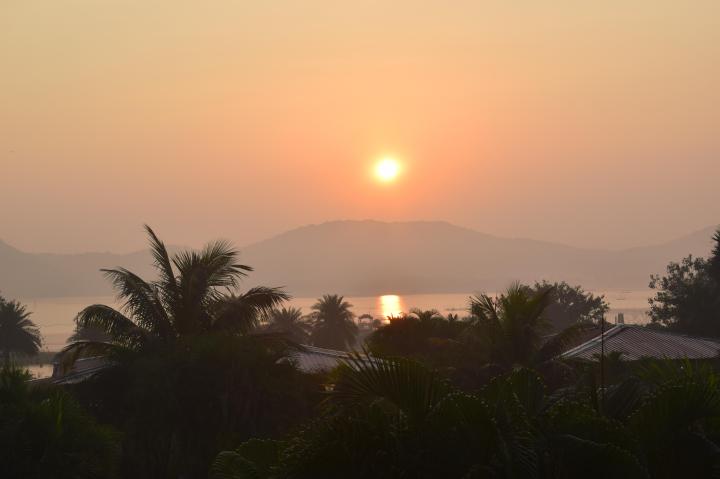
I woke up in the wee hours, when the sky was still dark, and watched the sun rise slowly over the hillocks and change the colours of the water. It was a good time of the year, spring was everywhere, flowers bloomed and the breeze was fragrant.
I walked to the jetty at the back of the hotel. Not many fishermen were out, lots of stray dogs were though. Or maybe most of the fisherfolk had gone off into deeper waters. But there were Egrets, Cormorants and more birds flitting around for food. Some sat on the poles from which the fishermen tied their boats.

From Rambha, you can hire a boat to go dolphin and bird watching to different islands like the Breakfast Island, Beacon Island and Birds Island. It is not advisable to chase the dolphins, as their fins could be harmed by the propellers.
Birds Island is home to many migratory birds. The main feature of this island is the droppings on granite rocks by avian species, making it appear white.
The little Beacon Island is three kilometres away from the jetty at Rambha. The beacon, a conical pillar with a light on top, was built by Mr Snodgrass, collector of the Ganjam district for the East India Company, way back in the British Raj. A tiny house was also constructed on a patch of half-submerged rock near Ghantasila Hill.
Sankuda Island, also known as Breakfast Island, has a rich reserve of floral species. Due to its pear-shaped appearance, it is also referred as Shank Island. This also has the remains of a dilapidated bungalow built by the king of Khallikote.
There is even a Honeymoon Island near Sankuda Island. Popularly known as Barkuda Island, it is dotted with trees and is home to many exotic aquatic species such as limbless lizards.
My plan to see the black buck habitat at Bania Chikili village did not succeed. Apparently, Google led us far from the core and by the time we found help, it was 10 am. A villager told us that the black buck had now gone deeper into the forest. This is a wildlife phenomenon—they come when they come!
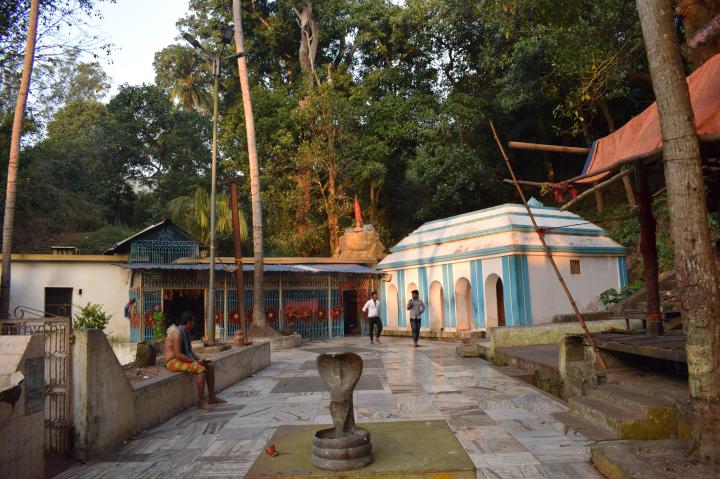
Other places of interest in this region are Jagannath temple, Gopalpur Sea Beach, Tampara Lake. Among the oldest and well known temples here are Nirmal Jhar and Narayani Devi.
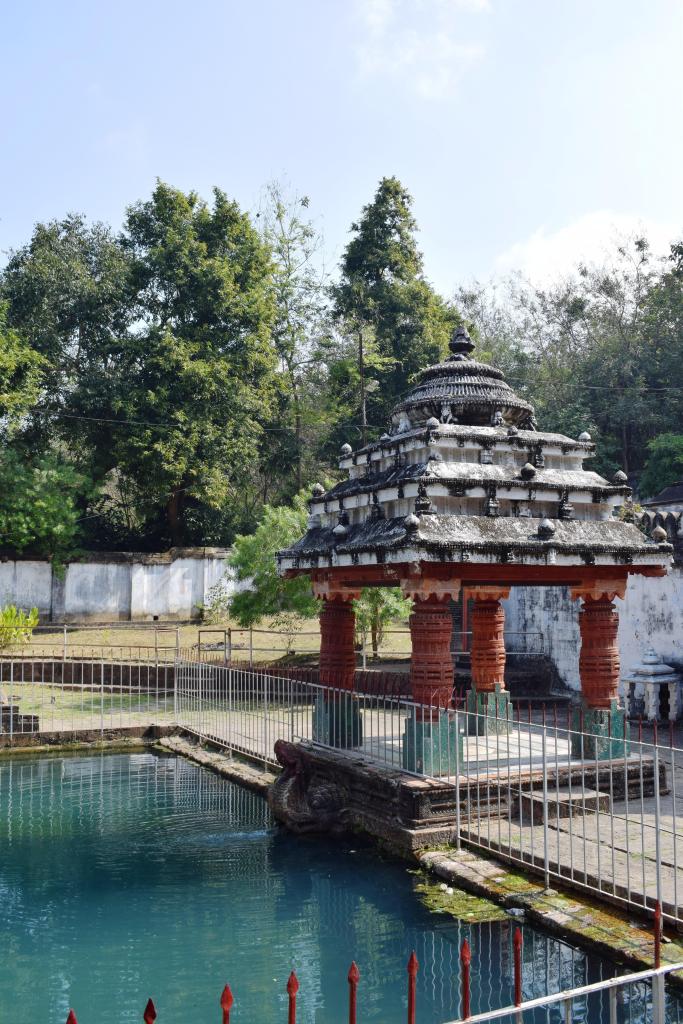
Nirmal Jhar or pure stream is a perennial stream flowing through a Vishnu temple. The sacred spring of Nirmal jhar originates from the foothills of Marua Mountain. The temple complex was constructed by Raja Aparajita Sri Balukeswar Mardaraj, the popular king of the Mardaraj dynasty of Khallikote, in 1676. There are dedicated shrines to Sri Nilkantheswar, Goddess Bimala, Sri Radhakrishna, Sri Jagannath the Sun God and there is a Magar Kund (crocodile pond) in this temple complex. So, we did stop here and then bought some really big, fat grapes and hit the road.
Barkul
This happens to be the buzzing tourist zone of the lake. We took the ride to Kalijai temple from here.
The gulls kept chasing boats, undeterred by the loud diesel engines. The fishermen remained busy on the other side of the jetty.

An 8-km refreshing boat ride over the waves and we reached Ma Kalijai Island, the patron deity of the lake. The temple was built by the Raja of Parikud. Locals and tourists seek the blessings of the goddess for a safe journey. There are stalls selling puja thalis and items, snacks and tea, and there’s a photographer’s pop-up too. He will take your pictures and give you a print in 2 minutes! Visitors can even enjoy a glass of sugarcane juice here.
For the fulfillment of their wishes, the devotees tie a small red or black cloth along with bangles on a pole and a tree on the island. And when the wishes are fulfilled, they come back with chicken and goats, so you see roosters living there with an old goat. There is a surge of pilgrims during Makar Sankranti in mid-January when a fair takes place here.
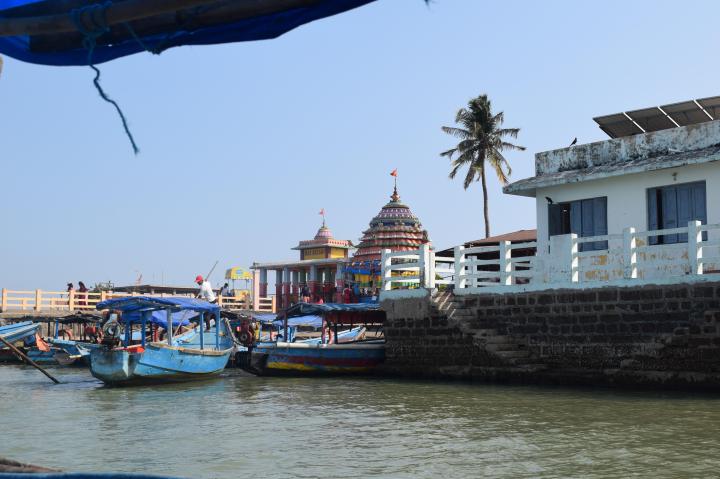
Locals share the legend of the temple. Long, long ago, a young bride called Jayi was travelling in a boat across the Chilika Lake from her village Banapur on her wedding day. All the guests were in the boat and they were heading for the island of Parikud where the groom lived. As twilight approached, a storm capsized the boat. Everyone aboard survived, except the young bride. The boatmen built a temple and enshrined an idol, praying for her safety. Natives now believe that Jayi protects all the boats and local people there. She resides in the shrine of Goddess Durga in the form of Goddess Kalijai.
Another tale says that the Raja of Khurdha launched an attack on the Raja of Parikud. With a small army, the Raja of Parikud knew all would be destroyed. He prayed to Goddess Kali for the safety of his people. Suddenly, a flock of flamingos landed on the island. From a distance, the Raja of Khurdha mistook the sea of flapping wings painted pink and white to be a massive army waving flags ready for war. He retreated and Parikud was saved. The temple was built by the king at the site in honour of Goddess Kali.
The Wetland Research and Training Centre, under the aegis of the Chilika Development Authority, is housed here along the shores.
From Barkul, visitors can also take a boat to Nalabana Bird Sanctuary on the protected Nalabana island. Flamingos, Gulls, Terns, Eagles, Goliath Heron, Ardea Goliath, Herons, Eurynorhynchus Pygmeus, Asian Dowitcher and Egrets are some of the common species that take shelter in the sanctuary. The island was closed to visitors during our visit.
Back at the jetty, we drove past a signboard that said Odi Art Centre and Museum. So, we took a detour to this folk and tribal art museum. Terracotta and metal sculptures lined the green pathways and the landscaped garden. The 16 galleries gave us a peek into the rural art, culture and literature of the state. It also has a gallery with folk art by international artists. I enjoyed the metal arts, terracotta arts, sculptures made with pencils and textiles too.
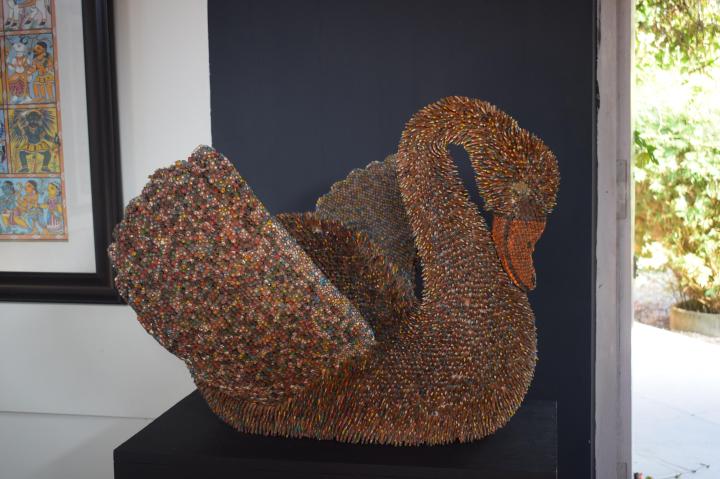
Fee: Rs 50;
Camera fee: Rs 100
Timings: Saturday and Sunday: 10.30am-6.30pm, Other days: 11am-5pm, Thursday closed
Other points along Chilika: Satapada, a lake side resort, is popular for dolphin sighting. A boat cruise to the nearby Rajahansa Island is apt for birders.
Things to keep in mind when going to Chilika Lake
1. Be up early, before sunrise and watch the vistas in this green region.
2. If you go in the peak season, September to March, then it’s best to do all your bookings in advance.
3. It is best to check the boat tours in advance, as they are only around for a few hours. You will need to pay extra if you want to keep the boat over the designated time.
4. Do not stand in the boat.
5. People are helpful to tourists and understand Hindi.
6. There is a lot of fresh seafood, but as I have turned vegetarian, I kept my meals limited to rice and lentils and veggies. You might enjoy some locally made vadas and samosas.
7. Carry your sunglasses, sunscreen, hat, water bottle and some snacks.
8. Take all your equipment in a separate bag and keep it ready for shoot, before the boat ride begins.
9. Wear clothes that blend in with the green surroundings and do not scare the birds.
10. Do not play loud music or leave eatables behind. Bring back only memories and photographs with you.

Where to stay in Chilika Lake
I stayed at the Odisha Tourism Development Corporation hotels, but I would suggest that you try other resorts. You can check on Tripadvisor. Only the hotel in Bhubaneswar is good. Most of these hotels have a check-out at 8 am and the food is not good.
How to reach Chilika Lake
There is an international airport at Bhubaneswar, capital of Odisha. From there you can hire a taxi, as it does take 6 hours to reach Rambha.
Then you can go to Barkul, the next day and finally to Mangalajodi on the last day, before driving back to the city.
My takeaways from the trip to Chilika Lake
1. Humans should not exploit their resources. The planet has evolved over billions of years and these natural resources need to be used slowly and replenished constantly.
2. Nature is abundant. Let us thank it for giving us a chance to enjoy this abundance.
3. Nothing is impossible when you pool in your knowledge and resources in an amicable way for a common good.
4. We will never be the same, ageing and dying is constant, but so is life.
5. Evolution is magic.
This post is part of Blogchatter’s CauseAChatter.
This blog post is part of the blog challenge ‘Blogaberry Dazzle’ hosted by Cindy D’Silva and Noor Anand Chawla in collaboration with Monidipa Dutta.


Very exhaustive post.
LikeLike
Thanks, I would say small, as it’s a blog post,, I would write over 5,000-word articles when i started my journalism career, 25 years ago. Writing has changed since then. 😛
LikeLike
Wow..I never knew Chilka Lake was the second-largest lagoon. I had gone some 25 years ago and really wanted to go for the boat ride but my husband didn’t want to. Did you sight any Dolphins? Your post on Chilka Lake is like a detailed guide to everything in and around it, Ambica.
LikeLiked by 1 person
I was doing this for a Guidebook, so got little time in each place. I didn’t see the dolphins as they are shy but some people do see if they hang around long in the boat in silence.
LikeLike
how can someone create such a detailed post about chills lake? The way you wrote about the restoration steps, flora fauna and how to reach there and what to remember while doing different activities like watching penguins. it must have been beautiful to see. I have seen penguins in Singapore.
LikeLike
Hi. Chilika lake is not the abode of penguins. However, there are many more water birds there.
LikeLiked by 1 person
I have visited Chilka lake some 5-7 years back and still remember the whole experience. It was so beautiful. We even got to see the dolphins too
LikeLiked by 1 person
I love bird watching and have been watching them regularly at the nearby Okhla bird sanctuary but Chilika is the mother of all sanctuaries with its huge bird population and turtles, dolphin, and even dugongs.
This post leaves out nothing for someone who is interested to know about the turnaround of Chilika lake and what to expect when visiting it.
LikeLiked by 1 person
I haven’t been to OBS in years! Must go this winter for sure, it’s so closeby.
LikeLike
That was one comprehensive write-up Ambica… so informative and loaded with interesting facts! I had heard of Chilika lake but I didn’t know anything much about it’s bio diversity. After your post, it has become as interesting as the sundarbans to me and has made way in my bucket list.
Btw, the pics are all lovely n the pencil sculpture is very creative.
LikeLiked by 1 person
Thanks Kaveri. Sunderbans is on my bucket list too.
LikeLike
This article on Chilika Lake’s unique ecosystem and conservation efforts is absolutely mesmerizing! Your firsthand experience and vivid descriptions make me feel like I’m there, exploring the vast shores and taking in the breathtaking views of the Eastern Ghats. It’s incredible to learn about the biodiversity thriving in this lagoon, especially the endangered Irrawaddy Dolphins and Olive-Ridley Turtles.
All the pix are amazing.
LikeLiked by 1 person
We visited Chilika Lake years back when we traveled to Puri. Just like your Ladakh posts, this one is also very detailed. I agree with you, nothing is impossible if everyone works together for the common good.
LikeLiked by 1 person
I visited Odisha twice and both time the main target was Puri Visit and some near areas of Bhubneshwar… But Chilka Lake visit never happened in both the times but we have again a plan to be in Puri in next year beginning for my son’s mundane and I want it to be a memorable one for my son and based on your recommendation Chilka Lake will be in my itinerary for sure. I love the humming of the birds as it creates a soothing effect in my mind. Honestly it turns me poetic and help me write few lines with positive vibes. I love photographing and so I will be ready before the boat starts with my mobi cam.
LikeLiked by 1 person
Ur visit to Chilka lake was definitely worth it not only for u but also for us. This review just felt like we are in mother natures arms. I enjoyed watching the bird pose for the pic.
LikeLiked by 1 person
Very comprehensive and informative blog post! I enjoyed reading and learning from it. I visited Rambha several years ago and loved that part of Chilika lake including boat rides for sunrise and sunset. Looks like there is so much more to see here. I want to visit Barkul and Mangalajodi and enjoy Chilika lake once again. Lovely images of birds! 🙂
LikeLiked by 1 person
Very detailed post. And it is nice to see some action being taken to preserve the ecosystem while not compromising on the Tourism.
LikeLike
A very comprehensive post. Enjoyed reading it. We had visited the Chilika Lake ages back when I was still in school. It is great to see the conservation efforts are paying off.
LikeLiked by 1 person
I have never read so much about Chilika lake ever. But your post is so interesting that I read it slowly, taking in all the information. I also liked the tips and feedback you have provided. Beautiful pics too, Ambica.
LikeLiked by 1 person
I am glad you enjoyed the post Janaki.
LikeLike
Being a Bengali, places in Odisha are like our backyard, even though we lived in North India. I visited Chillika when I was very young, 8 I think and although I remember so many things, including the scary legends, I don’t have many printed photographs of this place. Your post brought up my buried memories. I would loved to revisit, this time from a scientist’s perspective.
LikeLiked by 1 person
A boat ride in Chilika with the Eastern Ghats in the background would surely be a mesmerizing experience. It was great to read about all the efforts to restore the health of this lake and the ecosystem. Our ornithologist daughter would surely love to see the vast array of migratory birds that winter there. I am sure we would take tons of pictures if she did not travel with us – with or without our big zoom lens. I might be more interested in a boat trip to see the dolphins. A good tip to make sure to rise early and not miss those sunrises!
LikeLiked by 1 person
I’m so glad preservation efforts are being made to protect and improve Chilika Lake. As an avid birder, it makes me sad that the bird population has decreased. I hope the recent changes will attract so the different bird species back. Certainly will improve the ecosystem!
LikeLiked by 1 person
Birdwatching is so popular right now, and Chilika Lake seems like such an ideal spot to do so. It’s interesting to see how ecosystems develop and how we can impact them with what we do as tourists. I appreciate you highlighting such a natural resource!
LikeLiked by 1 person
As I went through this blog post on Chilika Lakes , I could not help but think about how my photographer friends would have a field day there. They would bring out their long range cameras and focus on the wildlife there which is very fascinating. It surprised me to read that dolphins are spotted as well. It is a good warning to leave them alone and not chase after them.
LikeLiked by 1 person
I absolutely love taking photographs of birds though I am not a professional. So, I have not heard of this lake and now seeing your pictures I really want to go there. That picture of the duck is on my bucketlist now 🙂 Thank you for sharing this!!
LikeLiked by 1 person
I will enjoy birdwatching in Chilika Lakes because they are abundant. It looks like visitors will always get to see birds as long as they catch them early in the morning. Both the sunset and sunrise at Chilika look beautiful, although I personally like the sunrise better from your picture. It looks tranquil. I’m glad for your tour guide who turned himself from a poacher to a protector and naturalist.
LikeLiked by 1 person
You would surely enjoy the birding ..it’s a fab place for that.
LikeLike
With so many bird species living there, Chilika Lake sounds like a great place to go if you are into birding. I think this would be such a relaxing experience, and a great way to learn more about the lagoon. I had no idea that it was so big, the second largest in the world. The mix of salt and fresh water also makes it very unique.
LikeLiked by 1 person
I also figured out the magnificence when I went there. It was such a natural marvel.
LikeLike
Due to these intriguing activities to do there, Chilika Lake appears to be a destination I’ll add to my trip wish list. The best time to visit seems to be during peak season to observe the numerous gorgeous birds and ducks. It’s also fascinating to visit the magnificent temples. I am happy that they took steps to restore this wonderful place.
LikeLiked by 1 person
Lake Chilika in Odisha is a beautiful place to visit as World’s second largest lagoon home to a wide variety of aquatic species and plants. And like you beautifully described its vast shores and endless horizons as if the sky and water mel into each other.It’s great how lake Chilika was restored to its old glory with a massive conservation efforts by the government of Odisha and Chilika Development Authority. We visited lake Chilika few years back during a trip to Puri and took a boat ride across vast lake and spotted Erawaddy dolphins and some birds and also visited Beacon islands . It was a very refreshing and enriching experience.But we didn’t visit Rambha, Mangaljodi and Barkul. The legend of the Kalujai temple is fascinating. These wetlands are essential sources of biodiversity and wintering ground for vast species of migratory birds. It’s nice how the erstwhile poachers at Mangaljodi have now turned into guides and protectors of nature.
LikeLiked by 1 person
Skip to content
Queen of Treasures
PRIMARY MENU
SEARCH
Flock at Mangalajodi, Chilika Lake, Odisha, India
ENVIRONMENT, PHOTOGRAPHY, TRAVEL
A Deep Dive into Chilika Lake’s Unique Ecosystem and Conservation Efforts
After a 3-day trip to the first Ramsar site in India, I realized how scientific techniques twinned with community-awareness can help a declining habitat flourish in many ways
Exploring Chilika is like flying off into space—the vast shores and endless horizon hide a multitude of mysteries. With the magnificent Eastern Ghats in the backdrop, a boat ride here in any part of the lake is a mesmerizing affair, as the sky and water melt into each other. Located south of the Mahanadi delta, it is spread over Puri, Khurda and Ganjam districts of Odisha. It is the second largest lagoon in the world, getting sea water from the Bay of Bengal and fresh water from rivers and streams. Given the biodiversity that thrives here, Chilika Lake feeds aquatic species and humans alike.
Chilika Lake, Odisha, is the largest brackish water lagoon in Asia. Covering an area of over 1,165 sq. km, it is home to over 323 aquatic species, which include the endangered Irrawaddy Dolphins and Olive-Ridley Turtles and more.
The lake is deep, I thought to myself as the boat sped towards Kalijai Island near Barkul. Sea gulls flew around the boats that offered them food. It was a moment I managed to capture.
Sea gulls follow the boat at Barkul as people feed them, Chilika Lake, Odisha, India
Sea gulls follow the boat at Barkul as people feed them, Chilika Lake, Odisha, India
There are many other parts to enjoy the biodiversity, out of which I visited Barkul, Rambha and Mangalajodi. Here, I realized why the lake is such a precious natural resource and how natural degradation had been reversed. In fact, the model became a global case study for other countries to emulate in their wetlands, and even a UNESCO article cites this.
Stork at Mangalajodi, Chilika Lake. Odisha, India
Stork at Mangalajodi, Chilika Lake. Odisha, India
Let me share the background of the lake, before I tell you about my trip to Mangalajodi and meeting the saviours of the marshy land.
Natural Resources Have a Life too
Chilika Lake is separated from the Bay of Bengal by a sandy ridge. Besides supporting aquatic flora and fauna, the water body is a source of livelihood for more than two lakh fishers, supporting 132 villages that live around its shores.
Advertisement
While the wetland was declared a Ramsar Site in 1981, the ecology degraded over the years, as the mouth of the lake was choked by siltation and sedimentation, leading to other problems. In 1993, the lake was placed on Montreux Record. Chilika Development Authority (CDA), under the aegis of the Government of Odisha, sprang into action and made a restoration plan. In 2002, the lake was pulled out of the record and also won the Ramsar Wetland Conservation Award in the same year.
Actions taken to restore Chilika Lake
1. An ‘Ecosystem Health Report Card’, first of its kind in Asia, was developed in collaboration with Maryland University and National Centre for Sustainable Coastal Management, Chennai. This is a quantitative assessment of lake health based on; Water clarity, Dissolved oxygen, Chlorophyll-a, Total catch, Commercial fish species diversity, Bird count and richness, Dolphin abundance, Benthic faunal diversity and Phytoplankton diversity.
2. Installation of the sensor mounted floating data buoys at 10 strategic locations for transmission of the water quality data on real-time basis at 15 minutes intervals to the CDA Laboratory at Chilika.
3. Upgradation of Wetlands Research & Training Center (WRTC) with a state-of-the-art lab, equipped with all modern research facility for wetland research.
4. Bridging knowledge gaps with five scientific studies:
(i) Comprehensive studies on water birds by Bombay Natural History Society, Mumbai
(ii) Fishery resources by ICAR-Central Inland Fisheries Research Institute. Kolkata
(iii) Study on the Benthos and meibenthos by Indian Institute of Science Education and Research, Pune
(iv) Study of microbes by KIIT School of Biotechnology, Bhubaneswar
(v) Study of macrophytes by Regional Plant Research Center, Bhubaneswar.
5. A documentary by renowned filmmaker Shekar Datatri to spread awareness.
6. Outreach programme ‘Rangers of Chilika’ was launched in collaboration with ‘Barefoot’, NGO from Puri. Awareness sessions and workshops with the communities dependent on the lake were held.
Flora & Fauna of Chilika Lake
The largest wintering ground for migratory birds, Chilika Lake is the ‘jewel of Odisha’. Nalabana Bird Sanctuary is the core area of the Ramsar-designated wetland. Birds come from as far as the Caspian Sea, Lake Baikal, Aral Sea and other remote parts of Russia, Kirghiz steppes of Mongolia, Central and Southeast Asia, Ladakh and Himalayas.
During the peak season, it is home to Flamingo, White Bellied Sea Eagle, Brahminy Kite, Spot-billed Pelican, Bar-headed Goose, Open-billed Stork, Spoonbill, Brahminy Duck, Wigeon, Pintail, Shoveler, Ibis, Stilt, Heron, Egret, Avocet, Gull, Tern and Kingfisher around the lake and on the many islands within the lake.
Brahminy Shelduck at Mangalajodi, Chilika Lake, Odisha, India
Brahminy Shelduck at Mangalajodi, Chilika Lake, Odisha, India
The thick tall-grass habitat in the northeastern part of the lagoon is the breeding ground of residential birds like Coots, Moorhens, Jacanas, Stilts, Dabchicks, Weaver bird and other species. Around 726 species of flowering plants have been documented here.
The lake also plays host to a few estuarine Turtles and Snakes; rare limbless skink and dugongs have been recorded here.
An afternoon lesson in birding at Mangalajodi
Chilika Lake became larger than life when I met poachers-turned-protectors at Mangalajodi. This is a fresh water zone connected by channels cut through the reed beds with the brackish water of Chilika lagoon.
The boatmen and the guides leading boat tours inside the 10 sq.km marshy channels are erstwhile poachers, now protectors and naturalists. The tours operate under the banner of Sri Sri Mahavir Pakshi Surakshya Samiti of Mangalajodi. The proud guardians were trained by the Chilika Development Authority, the forest department and Wild Orissa, an organization for conservation of wildlife and nature.
Tourists enjoy a boat ride at Mangalajodi, Chilika Lake, Odisha, India
Tourists enjoy a boat ride at Mangalajodi, Chilika Lake, Odisha, India
“The bird count had fallen to 5,000 in 2000,” said my guide, who parked me firmly in the front bow of the small, narrow wooden boat. Like the reeds, the boat was dark green and both, he and the boatman. wore greens too, blending with the natural habitat. “We would often kill these exotic species for sale and even our own consumption. But we were taught the folly of how we would lose the entire ecology and never have food.”
Stilt at Mangalajodi, Chilika Lake, Odisha, India
Stilt at Mangalajodi, Chilika Lake, Odisha, India
As a critical bird breeding habitat for a large variety of resident birds, Mangalajodi is among the most prized eco-tourism reserves in the state. With its significant global waterfowl habitat, it has been declared as an ‘Important Bird Area (IBA)’.
My guide started shooting out the names, pointing out the small birds near the shore. He had a big fat book on birding. “Do you understand English? How many birds come here now?” I asked.
“We were taught all the basics,” he replied. “I know all the pictures and about the birds and their names.”
This marshland has over 3,00,00 birds, which include Grebes, Cormorants/Shags, Herons, Egrets and Bitterns, Storks, Ibises, Geese and Ducks, Raptors, Pheasants, Partridges, Quails, Rails, Crakes, Moorhens, Coots, Jacanas, Waders, Gulls & Terns, Kingfishers, the rare Fishing Cat, Illisha (Hilsa illisha), Khainga (Mullet), Bhekti, Kanna and more.
Little Cormorant at Mangalajodi, Chilika Lake, Odisha, India
Little Cormorant at Mangalajodi, Chilika Lake, Odisha, India
Natives say that the village was named after the twin temples in the area. Mangal means welfare and jodi is twins.
As I didn’t have a telescopic lens, the boatman tried to take us as close to the birds as possible. But it wasn’t an easy task, and I didn’t try any stunts. My guide carried a pair of binoculars and handed me the pair to show me the formations in the sky.
I captured quite a few, watch the antics, the fights, the patterns they make in the sky and marvelled at the creation. “If you had the big lens, you would have got an award-winning video and picture,” my guide said. I just nodded, smiling ruefully. If I had come in the morning, then I would have seen more. But I had come at noon!
He also pointed out the watch towers, telling me that there were regular patrols and anti-poaching camps. For the lake to remain healthy, there has to be regular monitoring.
Pond Heron at Mangalajodi, Chilika Lake, Odisha, India
Pond Heron at Mangalajodi, Chilika Lake, Odisha, India
I watched a dead snake float by, frogs jump in and out of the water, fishermen taking their catch out and the birds were indifferent to us. The boat ride was for an hour and then the narrow, wooden transportation turned back towards the starting point.
Sunrise at Rambha
Surrounded by hills, the sunrise at Rambha is as exotic as the birds here. We had reached late in the evening, so I had an early night, turned out to be a good decision. I did have plans to take a boat tour of the islands here. But then, I decided that I would just explore the neighbourhood.
Sunrise at Rambha, Chilika Lake, Odisha, India
Sunrise at Rambha, Chilika Lake, Odisha, India
I woke up in the wee hours, when the sky was still dark, and watched the sun rise slowly over the hillocks and change the colours of the water. It was a good time of the year, spring was everywhere, flowers bloomed and the breeze was fragrant.
I walked to the jetty at the back of the hotel. Not many fishermen were out, lots of stray dogs were though. Or maybe most of the fisherfolk had gone off into deeper waters. But there were Egrets, Cormorants and more birds flitting around for food. Some sat on the poles from which the fishermen tied their boats.
Morning at Rambha jetty, Chilika Lake, Odisha, India
Morning at Rambha jetty, Chilika Lake, Odisha, India
From Rambha, you can hire a boat to go dolphin and bird watching to different islands like the Breakfast Island, Beacon Island and Birds Island. It is not advisable to chase the dolphins, as their fins could be harmed by the propellers.
Birds Island is home to many migratory birds. The main feature of this island is the droppings on granite rocks by avian species, making it appear white.
The little Beacon Island is three kilometres away from the jetty at Rambha. The beacon, a conical pillar with a light on top, was built by Mr Snodgrass, collector of the Ganjam district for the East India Company, way back in the British Raj. A tiny house was also constructed on a patch of half-submerged rock near Ghantasila Hill.
Sankuda Island, also known as Breakfast Island, has a rich reserve of floral species. Due to its pear-shaped appearance, it is also referred as Shank Island. This also has the remains of a dilapidated bungalow built by the king of Khallikote.
There is even a Honeymoon Island near Sankuda Island. Popularly known as Barkuda Island, it is dotted with trees and is home to many exotic aquatic species such as limbless lizards.
My plan to see the black buck habitat at Bania Chikili village did not succeed. Apparently, Google led us far from the core and by the time we found help, it was 10 am. A villager told us that the black buck had now gone deeper into the forest. This is a wildlife phenomenon—they come when they come!
Narayani Devi temple falls on the route between Rambha and Barkul, Odisha, Indi
Narayani Devi temple falls on the route between Rambha and Barkul, Odisha, India
Other places of interest in this region are Jagannath temple, Gopalpur Sea Beach, Tampara Lake. Among the oldest and well known temples here are Nirmal Jhar and Narayani Devi.
Magar kund, Nirmal Jhar, near Rambha, Odisha, India
Magar kund (crocodile pond), Nirmal Jhar, near Rambha, Odisha, India
Nirmal Jhar or pure stream is a perennial stream flowing through a Vishnu temple. The sacred spring of Nirmal jhar originates from the foothills of Marua Mountain. The temple complex was constructed by Raja Aparajita Sri Balukeswar Mardaraj, the popular king of the Mardaraj dynasty of Khallikote, in 1676. There are dedicated shrines to Sri Nilkantheswar, Goddess Bimala, Sri Radhakrishna, Sri Jagannath the Sun God and there is a Magar Kund (crocodile pond) in this temple complex. So, we did stop here and then bought some really big, fat grapes and hit the road.
Barkul
This happens to be the buzzing tourist zone of the lake. We took the ride to Kalijai temple from here.
The gulls kept chasing boats, undeterred by the loud diesel engines. The fishermen remained busy on the other side of the jetty.
Sea gulls enjoy their morning at Barkul, Odisha, India
Sea gulls enjoy their morning at Barkul, Odisha, India
An 8-km refreshing boat ride over the waves and we reached Ma Kalijai Island, the patron deity of the lake. The temple was built by the Raja of Parikud. Locals and tourists seek the blessings of the goddess for a safe journey. There are stalls selling puja thalis and items, snacks and tea, and there’s a photographer’s pop-up too. He will take your pictures and give you a print in 2 minutes! Visitors can even enjoy a glass of sugarcane juice here.
For the fulfillment of their wishes, the devotees tie a small red or black cloth along with bangles on a pole and a tree on the island. And when the wishes are fulfilled, they come back with chicken and goats, so you see roosters living there with an old goat. There is a surge of pilgrims during Makar Sankranti in mid-January when a fair takes place here.
Kalijai Island Dock, Barkul, Chilika Lake, Odisha, India
Kalijai Island Dock, Barkul, Chilika Lake, Odisha, India
Locals share the legend of the temple. Long, long ago, a young bride called Jayi was travelling in a boat across the Chilika Lake from her village Banapur on her wedding day. All the guests were in the boat and they were heading for the island of Parikud where the groom lived. As twilight approached, a storm capsized the boat. Everyone aboard survived, except the young bride. The boatmen built a temple and enshrined an idol, praying for her safety. Natives now believe that Jayi protects all the boats and local people there. She resides in the shrine of Goddess Durga in the form of Goddess Kalijai.
Another tale says that the Raja of Khurdha launched an attack on the Raja of Parikud. With a small army, the Raja of Parikud knew all would be destroyed. He prayed to Goddess Kali for the safety of his people. Suddenly, a flock of flamingos landed on the island. From a distance, the Raja of Khurdha mistook the sea of flapping wings painted pink and white to be a massive army waving flags ready for war. He retreated and Parikud was saved. The temple was built by the king at the site in honour of Goddess Kali.
The Wetland Research and Training Centre, under the aegis of the Chilika Development Authority, is housed here along the shores.
From Barkul, visitors can also take a boat to Nalabana Bird Sanctuary on the protected Nalabana island. Flamingos, Gulls, Terns, Eagles, Goliath Heron, Ardea Goliath, Herons, Eurynorhynchus Pygmeus, Asian Dowitcher and Egrets are some of the common species that take shelter in the sanctuary. The island was closed to visitors during our visit.
Back at the jetty, we drove past a signboard that said Odi Art Centre and Museum. So, we took a detour to this folk and tribal art museum. Terracotta and metal sculptures lined the green pathways and the landscaped garden. The 16 galleries gave us a peek into the rural art, culture and literature of the state. It also has a gallery with folk art by international artists. I enjoyed the metal arts, terracotta arts, sculptures made with pencils and textiles too.
Sculpture made of pencils, Odi Art Centre and Museum, Barkul, Odisha, India
Sculpture made of pencils, Odi Art Centre and Museum, Barkul, Odisha, India
Fee: Rs 50;
Camera fee: Rs 100
Timings: Saturday and Sunday: 10.30am-6.30pm, Other days: 11am-5pm, Thursday closed
Other points along Chilika: Satapada, a lake side resort, is popular for dolphin sighting. A boat cruise to the nearby Rajahansa Island is apt for birders.
Things to keep in mind when going to Chilika Lake
1. Be up early, before sunrise and watch the vistas in this green region.
2. If you go in the peak season, September to March, then it’s best to do all your bookings in advance.
3. It is best to check the boat tours in advance, as they are only around for a few hours. You will need to pay extra if you want to keep the boat over the designated time.
4. Do not stand in the boat.
5. People are helpful to tourists and understand Hindi.
6. There is a lot of fresh seafood, but as I have turned vegetarian, I kept my meals limited to rice and lentils and veggies. You might enjoy some locally made vadas and samosas.
7. Carry your sunglasses, sunscreen, hat, water bottle and some snacks.
8. Take all your equipment in a separate bag and keep it ready for shoot, before the boat ride begins.
9. Wear clothes that blend in with the green surroundings and do not scare the birds.
10. Do not play loud music or leave eatables behind. Bring back only memories and photographs with you.
Egret at Mangalajodi, Chilika Lake, Odisha, India
Egret at Mangalajodi, Chilika Lake, Odisha, India
Where to stay in Chilika Lake
I stayed at the Odisha Tourism Development Corporation hotels, but I would suggest that you try other resorts. You can check on Tripadvisor. Only the hotel in Bhubaneswar is good. Most of these hotels have a check-out at 8 am and the food is not good.
How to reach Chilika Lake
There is an international airport at Bhubaneswar, capital of Odisha. From there you can hire a taxi, as it does take 6 hours to reach Rambha.
Then you can go to Barkul, the next day and finally to Mangalajodi on the last day, before driving back to the city.
My takeaways from the trip to Chilika Lake
1. Humans should not exploit their resources. The planet has evolved over billions of years and these natural resources need to be used slowly and replenished constantly.
2. Nature is abundant. Let us thank it for giving us a chance to enjoy this abundance.
3. Nothing is impossible when you pool in your knowledge and resources in an amicable way for a common good.
4. We will never be the same, ageing and dying is constant, but so is life.
5. Evolution is magic.
This post is part of Blogchatter’s CauseAChatter.
This blog post is part of the blog challenge ‘Blogaberry Dazzle’ hosted by Cindy D’Silva and Noor Anand Chawla in collaboration with Monidipa Dutta.
PUBLISHED BY
Ambica Gulati
When you flow like water, every rock is penetrable. Writing is serendipity. I did not plan a career in journalism 25 years back. And I did not plan on starting a blog either or learning photography and videography. I just follow the course that life sets for me and I share all those stories through words, visuals and videos on the blog. Happy reading!
View all posts by Ambica Gulati
JUNE 22, 2023
BEAUTIFUL DESTINATIONS, BIRDING IN INDIA, COMMUNITY-LED TOURISM, ECO-TOURISM IN INDIA, FISHING IN INDIA, INCREDIBLE INDIA, NATURAL RESOURCES, ODISHA TOURISM, RAMSAR SITES IN INDIA, RESPONSIBLE TRAVEL, SLOW TRAVEL, TRAVEL FEATURE, WETLANDS OF INDIA, WHERE TO SEE WATER BIRDS
SHARE THIS:
PINTEREST2SCOOPITFACEBOOKWHATSAPPTELEGRAMTWITTERLINKEDINPRINTEMAILTUMBLR
LIKE THIS:
LOADING…
Related
Early Morning at Sukhna Lake, Chandigarh, India
Chandigarh makes for a perfect family vacay
December 23, 2021
IN “SUSTAINABLE LIVING”
Beautiuk Ladakh, India
Innovative Sustainable Tourism Practices in Ladakh You Need to Know About
June 16, 2023
IN “ENVIRONMENT”
Tribal art, Odisha State Tribal Museum, Bhubaneswar, Odisha, India
Visiting The Temple City, BHUBANESWAR
April 2, 2023
IN “PHOTOGRAPHY”
32 thoughts on “A Deep Dive into Chilika Lake’s Unique Ecosystem and Conservation Efforts”
Matheikal
JUNE 23, 2023 AT 11:31 AM
Very exhaustive post.
Like
REPLY
Ambica Gulati
JUNE 23, 2023 AT 11:37 AM
Thanks, I would say small, as it’s a blog post,, I would write over 5,000-word articles when i started my journalism career, 25 years ago. Writing has changed since then. 😛
Like
REPLY
jeetjinder
JUNE 29, 2023 AT 7:29 PM
Wow..I never knew Chilka Lake was the second-largest lagoon. I had gone some 25 years ago and really wanted to go for the boat ride but my husband didn’t want to. Did you sight any Dolphins? Your post on Chilka Lake is like a detailed guide to everything in and around it, Ambica.
Liked by 1 person
REPLY
Ambica Gulati
JUNE 29, 2023 AT 8:22 PM
I was doing this for a Guidebook, so got little time in each place. I didn’t see the dolphins as they are shy but some people do see if they hang around long in the boat in silence.
Like
REPLY
Sivaranjini Anandan
JULY 2, 2023 AT 7:34 PM
how can someone create such a detailed post about chills lake? The way you wrote about the restoration steps, flora fauna and how to reach there and what to remember while doing different activities like watching penguins. it must have been beautiful to see. I have seen penguins in Singapore.
Like
REPLY
Ambica Gulati
JULY 2, 2023 AT 8:44 PM
Hi. Chilika lake is not the abode of penguins. However, there are many more water birds there.
Liked by 1 person
Aastha Anand
JUNE 30, 2023 AT 9:22 AM
I have visited Chilka lake some 5-7 years back and still remember the whole experience. It was so beautiful. We even got to see the dolphins too
Liked by 1 person
REPLY
Preeti Chauhan
JUNE 30, 2023 AT 11:37 AM
I love bird watching and have been watching them regularly at the nearby Okhla bird sanctuary but Chilika is the mother of all sanctuaries with its huge bird population and turtles, dolphin, and even dugongs.
This post leaves out nothing for someone who is interested to know about the turnaround of Chilika lake and what to expect when visiting it.
Liked by 1 person
REPLY
Ambica Gulati
JUNE 30, 2023 AT 1:14 PM
I haven’t been to OBS in years! Must go this winter for sure, it’s so closeby.
Like
REPLY
Kaveri Chhetri
JUNE 30, 2023 AT 2:05 PM
That was one comprehensive write-up Ambica… so informative and loaded with interesting facts! I had heard of Chilika lake but I didn’t know anything much about it’s bio diversity. After your post, it has become as interesting as the sundarbans to me and has made way in my bucket list.
Btw, the pics are all lovely n the pencil sculpture is very creative.
Liked by 1 person
REPLY
Ambica Gulati
JUNE 30, 2023 AT 4:38 PM
Thanks Kaveri. Sunderbans is on my bucket list too.
Like
REPLY
Anjali
JULY 1, 2023 AT 8:23 AM
This article on Chilika Lake’s unique ecosystem and conservation efforts is absolutely mesmerizing! Your firsthand experience and vivid descriptions make me feel like I’m there, exploring the vast shores and taking in the breathtaking views of the Eastern Ghats. It’s incredible to learn about the biodiversity thriving in this lagoon, especially the endangered Irrawaddy Dolphins and Olive-Ridley Turtles.
All the pix are amazing.
Liked by 1 person
REPLY
Madhu Bindra
JULY 1, 2023 AT 5:53 PM
We visited Chilika Lake years back when we traveled to Puri. Just like your Ladakh posts, this one is also very detailed. I agree with you, nothing is impossible if everyone works together for the common good.
Liked by 1 person
REPLY
Samata
JULY 1, 2023 AT 9:31 PM
I visited Odisha twice and both time the main target was Puri Visit and some near areas of Bhubneshwar… But Chilka Lake visit never happened in both the times but we have again a plan to be in Puri in next year beginning for my son’s mundane and I want it to be a memorable one for my son and based on your recommendation Chilka Lake will be in my itinerary for sure. I love the humming of the birds as it creates a soothing effect in my mind. Honestly it turns me poetic and help me write few lines with positive vibes. I love photographing and so I will be ready before the boat starts with my mobi cam.
Liked by 1 person
REPLY
Flavia Cutinho
JULY 2, 2023 AT 8:49 AM
Ur visit to Chilka lake was definitely worth it not only for u but also for us. This review just felt like we are in mother natures arms. I enjoyed watching the bird pose for the pic.
Liked by 1 person
REPLY
Jan Banerjee
JULY 2, 2023 AT 9:42 AM
Very comprehensive and informative blog post! I enjoyed reading and learning from it. I visited Rambha several years ago and loved that part of Chilika lake including boat rides for sunrise and sunset. Looks like there is so much more to see here. I want to visit Barkul and Mangalajodi and enjoy Chilika lake once again. Lovely images of birds! 🙂
Liked by 1 person
REPLY
Vasumathi
JULY 2, 2023 AT 4:02 PM
Very detailed post. And it is nice to see some action being taken to preserve the ecosystem while not compromising on the Tourism.
Like
REPLY
Ritu Bindra
JULY 2, 2023 AT 6:18 PM
A very comprehensive post. Enjoyed reading it. We had visited the Chilika Lake ages back when I was still in school. It is great to see the conservation efforts are paying off.
Liked by 1 person
REPLY
Janaki
JULY 2, 2023 AT 6:33 PM
I have never read so much about Chilika lake ever. But your post is so interesting that I read it slowly, taking in all the information. I also liked the tips and feedback you have provided. Beautiful pics too, Ambica.
Liked by 1 person
REPLY
Ambica Gulati
JULY 2, 2023 AT 7:13 PM
I am glad you enjoyed the post Janaki.
Like
REPLY
docdivatraveller
JULY 3, 2023 AT 6:45 AM
Being a Bengali, places in Odisha are like our backyard, even though we lived in North India. I visited Chillika when I was very young, 8 I think and although I remember so many things, including the scary legends, I don’t have many printed photographs of this place. Your post brought up my buried memories. I would loved to revisit, this time from a scientist’s perspective.
Liked by 1 person
REPLY
Linda (LD Holland)
JULY 4, 2023 AT 7:06 PM
A boat ride in Chilika with the Eastern Ghats in the background would surely be a mesmerizing experience. It was great to read about all the efforts to restore the health of this lake and the ecosystem. Our ornithologist daughter would surely love to see the vast array of migratory birds that winter there. I am sure we would take tons of pictures if she did not travel with us – with or without our big zoom lens. I might be more interested in a boat trip to see the dolphins. A good tip to make sure to rise early and not miss those sunrises!
Liked by 1 person
REPLY
Tami
JULY 5, 2023 AT 12:34 AM
I’m so glad preservation efforts are being made to protect and improve Chilika Lake. As an avid birder, it makes me sad that the bird population has decreased. I hope the recent changes will attract so the different bird species back. Certainly will improve the ecosystem!
Liked by 1 person
REPLY
Jennifer Prince
JULY 6, 2023 AT 1:07 AM
Birdwatching is so popular right now, and Chilika Lake seems like such an ideal spot to do so. It’s interesting to see how ecosystems develop and how we can impact them with what we do as tourists. I appreciate you highlighting such a natural resource!
Liked by 1 person
REPLY
Adele
JULY 6, 2023 AT 3:12 AM
As I went through this blog post on Chilika Lakes , I could not help but think about how my photographer friends would have a field day there. They would bring out their long range cameras and focus on the wildlife there which is very fascinating. It surprised me to read that dolphins are spotted as well. It is a good warning to leave them alone and not chase after them.
Liked by 1 person
REPLY
Shalini
JULY 6, 2023 AT 9:34 AM
I absolutely love taking photographs of birds though I am not a professional. So, I have not heard of this lake and now seeing your pictures I really want to go there. That picture of the duck is on my bucketlist now 🙂 Thank you for sharing this!!
Liked by 1 person
REPLY
Umiko
JULY 7, 2023 AT 1:07 AM
I will enjoy birdwatching in Chilika Lakes because they are abundant. It looks like visitors will always get to see birds as long as they catch them early in the morning. Both the sunset and sunrise at Chilika look beautiful, although I personally like the sunrise better from your picture. It looks tranquil. I’m glad for your tour guide who turned himself from a poacher to a protector and naturalist.
Liked by 1 person
REPLY
Ambica Gulati
JULY 7, 2023 AT 5:58 PM
You would surely enjoy the birding ..it’s a fab place for that.
Like
REPLY
Joanna
JULY 8, 2023 AT 4:35 PM
With so many bird species living there, Chilika Lake sounds like a great place to go if you are into birding. I think this would be such a relaxing experience, and a great way to learn more about the lagoon. I had no idea that it was so big, the second largest in the world. The mix of salt and fresh water also makes it very unique.
Liked by 1 person
REPLY
Ambica Gulati
JULY 8, 2023 AT 4:39 PM
I also figured out the magnificence when I went there. It was such a natural marvel.
Like
REPLY
Maria Veloso
JULY 9, 2023 AT 8:28 AM
Due to these intriguing activities to do there, Chilika Lake appears to be a destination I’ll add to my trip wish list. The best time to visit seems to be during peak season to observe the numerous gorgeous birds and ducks. It’s also fascinating to visit the magnificent temples. I am happy that they took steps to restore this wonderful place.
Liked by 1 person
REPLY
Puloma.B
JULY 11, 2023 AT 12:57 AM
Lake Chilika in Odisha is a beautiful place to visit as World’s second largest lagoon home to a wide variety of aquatic species and plants. And like you beautifully described its vast shores and endless horizons as if the sky and water mel into each other.It’s great how lake Chilika was restored to its old glory with a massive conservation efforts by the government of Odisha and Chilika Development Authority. We visited lake Chilika few years back during a trip to Puri and took a boat ride across vast lake and spotted Erawaddy dolphins and some birds and also visited Beacon islands . It was a very refreshing and enriching experience.But we didn’t visit Rambha, Mangaljodi and Barkul. The legend of the Kalujai temple is fascinating. These wetlands are essential sources of biodiversity and wintering ground for vast species of migratory birds. It’s nice how the erstwhile poachers at Mangaljodi have now turned into guides and protectors of nature.
LikeLike
What an incredibly detailed post! I really hope to visit Chilika Lake someday.
LikeLiked by 1 person